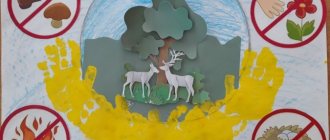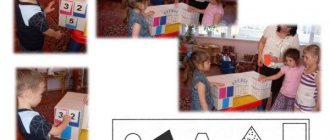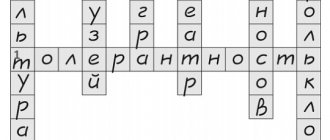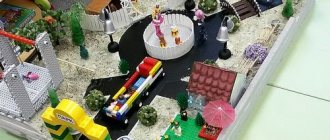Play in preschool age Consultation for teachers. - presentation
Play in preschool age Consultation for teachers
Play is the most accessible type of activity for children, a way of processing impressions and knowledge received from the surrounding world. The game clearly reveals the characteristics of the child’s thinking and imagination, his emotionality, activity, and developing need for communication.
The role of play in the development of a child The role of play in the development of a child Recently, scientists have been searching (Z.M. Boguslavskaya, O.M. Dyachenko, A.K. Bondarenko, N.E. Veraksa, E.O. Smirnova, Z.A. Mikhailova and others) are moving towards creating a series of games for the full development of children's intelligence, which are characterized by flexibility, initiative of thought processes, and the transfer of formed mental actions to new content. These games often have no fixed rules. On the contrary, children are faced with the need to choose ways to solve a problem. The authors more often call the proposed games educational, rather than traditionally didactic. Play studies in recent decades have shown that children who play a lot and intensely show success in the following areas: 1. In the emotional sphere - better understanding, experiencing and processing of feelings; children cope better with negative experiences, disappointments and failures; aggressiveness is less pronounced; higher ability to withstand “emotional overload”; increased overall psychological stability; greater satisfaction; a more balanced ratio of the basic feelings of fear, joy, sadness, anger; 2. In the communication sphere, children listen to their partner better; increased readiness for cooperation; better recognize the rules of interaction; increased sensitivity to injustice; increased ability to form friendships; 3. In the motor sphere - a higher ability to react quickly; improved eye-hand coordination; more differentiated gross and fine motor skills; better sense of body balance; more highly developed volitionality; 4. In the cognitive sphere - children show higher development of logical thinking; higher ability to concentrate; better memory; more differentiated and developed speech; developed imagination; better understanding of figures, numbers, letters and other signs.
CLASSIFICATION OF GAMES OF PRESCHOOL CHILDREN (according to E.V. Zworygina and S.L. Novoselova) Games that arise on the initiative of children Experimental games Games with natural objects Games with toys Games with animals Story-based amateur games Story-representative Story-role-playing Director's Theatrical Games , arising on the initiative of an adult Educational games Plot-didactic Mobile Musical-didactic Educational Leisure games Intellectual Games-fun, entertainment Theatrical Festive-carnival Computer Folk games Ritual games Family Seasonal Cult Training games Intellectual Sensorimotor Adaptive Leisure games Rumbles Quiet games Fun games
Types of game material for games with rules: 1) material for games on physical competence (movement, dexterity), 2) material for games of chance (chance), 3) material for games on mental development. For games for physical development, these are materials (objects, sets of objects) that support effective action according to the rule. Examples of such materials include balls, throwing bags, sets of pins, ring throwers, etc. For games of luck (chance), there are specially created board games such as “goose” and “lotto” with a wide variety of thematic content. The subject support of games with rules for mental development are also board games: children's dominoes (with pictures), as well as checkers, chess, backgammon, etc., which are no different from “adult” games. It should be borne in mind that there are many traditional games with rules for preschoolers that do not have a substantive basis and are regulated only by verbal agreement. These can be outdoor games (for example, “tag”), as well as a large class of games for mental development, so-called verbal games - for exercising attention, memory, combinatorics (for example, the game “Don’t say yes and no”, “Loading the steamer” and so on.).
Game as the leading activity of preschool children CHARACTERISTICS OF STORY-LOTED AMATEUR GAME The basis of plot-role-playing game is an imaginary or imaginary situation. A characteristic feature is the independence of children. Through the game, the child embodies his views and ideas. Children reflect their attitude towards the event that they are acting out. CHARACTERISTICS OF STORY-LOCKED AMATEUR ACTIVITY GAME. The basis of the plot. - role-playing game - an imaginary or imaginary situation. A characteristic feature is the independence of children. Through the game, the child embodies his views, ideas. Children reflect their attitude to the event that they are acting out. PREREQUISITES OF PLOT - ROLE-PLAYING The first stage is an introductory game. The adult organizes the child’s object-based play activity using various toys and objects The second stage is a display game. The child’s actions are aimed at identifying the specific properties of an object and achieving a certain effect with its help. The third stage is a plot-display game. Children actively reflect the impressions received in everyday life. PREREQUISITES OF STORY-ROLE PLAY The first stage is introductory game An adult organizes the child’s object-based play activities using a variety of toys and objects. The second stage is a display game. The child’s actions are aimed at identifying the specific properties of an object and achieving a certain effect with its help. The third stage is a plot-display game. Children actively reflect the impressions received in everyday life. life
Game as the leading activity of preschool children FORMATION OF RELATIONSHIPS IN STORY-ROLE PLAY (A.P. Usova) The level of disorganized behavior that leads to the destruction of the games of other children The level of solitary games, at which the child does not interact with other children, but also does not prevents them from playing The level of side-by-side games, when children can play together, but each acts in accordance with their own game goal The level of short-term communication, in which the child subordinates his actions to a common plan for some time The level of long-term communication, in which interaction occurs based on interest to the content of the game The level of constant interaction based on common interests, selective sympathies FORMATION OF RELATIONSHIPS IN STORY-ROLE PLAY GAME (A.P. Usova) The level of disorganized behavior that leads to the destruction of the games of other children The level of single games at which the child does not interact with other children, but does not prevent them from playing. The level of games nearby, when children can play together, but each acts in accordance with their play goal. The level of short-term communication, in which the child for some time subordinates his actions to the general plan. The level of long-term communication, at in which interaction occurs based on interest in the content of the game Level of constant interaction based on common interests, selective sympathies
Game as a leading activity for preschool children COMPONENTS OF STORY-ROLE PLAY Plot of the game The sphere of reality that is reproduced by children, a reflection of certain actions, events from life and the activities of others Content of the game What is reproduced by the child as the central and characteristic moment of activity and relationships between adults in their everyday, work and social activities Role and play position in which the child identifies himself with any character in the plot and acts in accordance with ideas about this character COMPONENTS OF PLOT - ROLE PLAY The plot of the game The sphere of reality that is reproduced by children, a reflection of certain actions , events from the life and activities of others Content of the game What is reproduced by the child as the central and characteristic moment of activity and relationships between adults in their everyday, work and social activities Role and play position in which the child identifies himself with any character in the plot and acts in accordance with the ideas about this character
Game as a leading activity for preschool children Thematic amateur game as an activity makes a number of demands on the child that contribute to the formation of mental new formations: Action in the imaginary plane contributes to the development of the symbolic function of thinking The presence of an imaginary situation contributes to the formation of a plan of ideas The game is aimed at reproducing human relationships, therefore, it contributes to developing the child’s ability to navigate them in a certain way. The need to coordinate play actions contributes to the formation of real relationships between playing children
Game as a leading activity for preschool children Method of guiding role-playing games N.Ya. Mikhailenko and N.A. Korotkova The third principle: at each age stage, when developing gaming skills, it is necessary to orient children both to the implementation of a gaming action and to explaining its meaning to partners. The third principle: at each age stage, when developing gaming skills, it is necessary to orient children both to the implementation game action, and to explain its meaning to partners First principle: in order for children to master gaming skills, the teacher must play with them First principle: in order for children to master gaming skills, the teacher must play with them Second principle: on At each age stage, the game unfolds in a special way, so that children “discover” and assimilate a new, more complex way of constructing the game. Second principle: at each age stage, the game unfolds in a special way, so that children “discover” and assimilate a new, more complex way game building 10
Game as a leading activity for preschool children A comprehensive method for guiding play E.V. Zvorygina, S.L. Novoselova Complex method of game management E.V. Zvorygina, S.L. Novoselova 4. Activation of problematic communication between an adult and children 3. Developmental object-based play environment 2. Transfer of gaming culture to a child (educational games, leisure games, folk games) 1. Enrichment of children with knowledge and experience of activities 11
For children, play, which is commonly called a “childhood companion,” constitutes the main content of life, is a leading activity, and is closely intertwined with work and learning. All aspects of the personality are involved in the game: the child moves, speaks, perceives, thinks; During the game, all his mental processes are actively working: thinking, imagination, memory, emotional and volitional manifestations are intensified. The game acts as an important means of education.
Thank you for your attention





